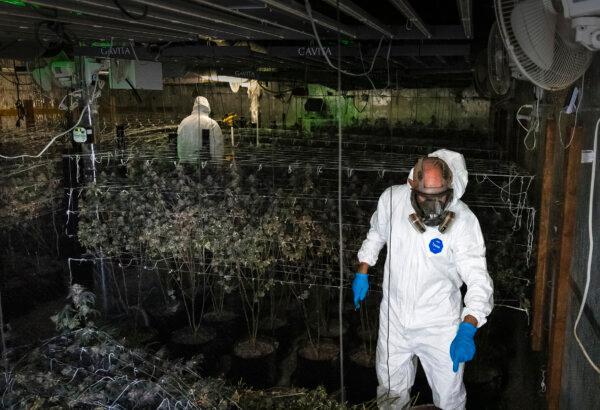On her first day after moving from Australia to the United States, Elizabeth Dunford walked into a supermarket to buy bread. As a researcher of food additives, she instinctively glanced at the ingredients label.
“Why are there so many additives?” she exclaimed in surprise. Nearly every loaf she picked up contained ingredients that made her uneasy. After lingering by the shelves, she reluctantly chose a bag.
“At that moment, I thought: It looks like I will have to choose the best from the worst when shopping in the future,” Ms. Dunford, project consultant for The George Institute for Global Health and adjunct assistant professor in the department of nutrition at the University of North Carolina, told The Epoch Times.
Today,
more than 73 percent of the U.S. food supply is ultra-processed. While both natural and ultra-processed foods are referred to as “food,” there is a vast difference between them. For instance, ultra-processed foods are not grown in soil but manufactured in factories, using many ingredients that cannot be found in the average home pantry.
Beyond conventional additives such as preservatives, colors, and flavorings, many new additives are emerging. Stabilizers, emulsifiers, firming agents, leavening agents, anti-caking agents, humectants, and more have been invented to modify the taste and texture of food.
The U.S. Food and Drug Administration (FDA) lists at least
3,972 substances added to food.
Perhaps driven by a growing desire for richer and more varied flavors or by the pressures of fast-paced living, people have become accustomed to these substances, even considering them a natural part of the modern diet.
Then and Now
In the old days, families used salt and vinegar to preserve food. But with the advent of the industrial age, people became increasingly reliant on ready-made foods available on supermarket shelves.“By the mid-20th century, more and more food additives were being used,” said Mona Calvo, who has a doctorate in nutritional sciences. Ms. Calvo is an adjunct professor in the department of medicine at the Icahn School of Medicine at Mount Sinai.
Only recently have people begun to pay closer attention to what goes into the foods they eat.
People have become increasingly reliant on ready-made foods. Employees supervise chicken pieces being processed into nuggets on a conveyer belt. Alain Jocard/AFP via Getty Images
In the 1950s to 1970s, the FDA began evaluating the safety of common food additives, Ms. Calvo told The Epoch Times.
“A safety assessment involves the scientific review of all relevant data, including toxicology and dietary exposure information,” an FDA spokesperson told The Epoch Times. These include tests conducted on rodents and cells. The ingredients will be added to food after the FDA gives its approval.
Consumers can identify what is in their packaged foods by the nutrition facts and ingredient labels, Ms. Calvo said.
Among the most widely used FDA-approved substances added to food, many have a safety classification known as “generally recognized as safe” (GRAS)
based on their extensive historical use before 1958 or their safety evaluation in the 1970s or more recently.

However, there’s no limit on the amount of some substances classified as GRAS that can be added to food. In many cases, the quantity added is based on Current Good Manufacturing Practice (CGMP) guidelines.
Over time, GRAS classification may be withdrawn for certain substances if the FDA is presented with compelling evidence of safety concerns associated with its use. A notable example is the official removal of trans fats from the GRAS list
in 2015.
Ms. Calvo pointed out another unresolved issue: There is no oversight on how much of these additive-containing foods people actually consume.
“Many of the commonly used food additives were granted GRAS approval between 1970 and 1975, when people could not foresee the situation today,” she said.
During that era, fewer women worked outside the home, and people consumed more home-cooked meals made from natural ingredients. With the prevalence of ultra-processed foods in today’s diet, the consumption of certain additives has naturally exceeded initial expectations.
The FDA officially removed trans fats from the GRAS list in 2015. Spencer Platt/Getty Images
After an additive is approved for a specific function, food manufacturers often quickly incorporate it into a wide range of products, including breads, cookies, instant soups, sausages, and frozen, prepackaged meals.
Dr. Jaime Uribarri, a nephrology specialist at the Icahn School of Medicine at Mount Sinai who has long been concerned about specific food additives, told The Epoch Times that “once an additive-containing packaged food is in the marketplace, the FDA does not have a mechanism for regularly testing its safety, such as through periodic sampling checks.”
The Useful and the Unnecessary
Objectively speaking, some food additives may offer more benefits than drawbacks, Ms. Dunford said.Preservatives, for example, help extend the shelf life of food. Adding a moderate amount of nitrites to cured meats can prevent botulism, a serious condition.
However, she pointed out that many additives that enhance color, flavor, and other sensory aspects are “essentially not necessary.”
Scientists have demonstrated in various studies the
health hazards of consuming ultra-processed foods, including their close association with early death, cardiovascular diseases, mental disorders, respiratory diseases, metabolic syndrome, and cancer.
Specifically, a
cohort study involving nearly 45,000 middle-aged and older individuals in France found that for every 10 percent increase in the intake of ultra-processed foods, the risk of all-cause mortality increased by 14 percent. According to a
2024 umbrella review published in the BMJ, convincing evidence has been found linking ultra-processed food to a 50 percent increase in cardiovascular disease mortality, a 53 percent increase in common mental disorder outcomes, and a dose-dependent 12 percent increase in diabetes risk.
Ultra-processed food is linked to significant increases in cardiovascular disease mortality, mental disorder outcomes, and diabetes risks. The Epoch Times
While part of the increased risks can be attributed to the use of high-sugar, high-salt, high-fat, and low-fiber ingredients, some additives previously thought to be safe also warrant attention.
“Phosphate additives is one that I’m very wary of,” Ms. Dunford said.
Phosphate Additives
A
2023 study published in the Journal of Renal Nutrition found that of all the 3,466 U.S. packaged foods tested, more than half contained phosphate additives.
Phosphate additives encompass a range of substances with various functions, such as stabilizing, thickening, emulsifying, adjusting acidity and alkalinity, improving texture, enhancing flavor, providing antioxidant properties, preserving, and coloring. Some phosphates serve multiple functions simultaneously.
Multiple studies have shown that the health hazards associated with consuming ultra-processed foods are linked to a high intake of inorganic phosphates.
The body’s absorption rate and utilization efficiency for phosphorus vary depending on the source. When a person eats natural foods, the release of phosphorus is relatively slow, and not all of it is absorbed. In contrast, inorganic phosphate food additives are quickly absorbed into the bloodstream, significantly increasing blood phosphate levels and
releasing hormones that promote phosphate excretion. These hormones can have a range of adverse effects on the cardiovascular system, kidneys, and bones, resulting in reduced vitamin D levels, bone loss,
vascular calcification, and impaired kidney filtration capacity.
Using inorganic phosphate additives in animal or cell experiments results in immediate side effects.
“That gives you enough rationale to suspect that these may happen also in humans,” Dr. Uribarri said.
More than 50 types of phosphate additives, including about 30 types of inorganic phosphates, have been approved by the FDA and are frequently used. These additives are classified as GRAS, meaning their quantity allowance and types are largely unregulated. According to a 2023 study
published in Nutrients, 59 percent of ready-made meals and 47 percent of processed meats contain inorganic phosphates.
The daily recommended intake of phosphorus is 700 milligrams. Most Americans consume a
significantly higher amount, with adult women consuming an average of 1,189 milligrams per day and men consuming 1,596 milligrams.
One study tracking adult Swedish women for nine years showed that those with higher phosphorus levels in their bodies, attributed to consuming more phosphorus-rich ultra-processed foods, had a 57 percent higher risk of developing cardiovascular diseases.
Another study involving nearly 10,000 American adults indicated that one’s mortality rate began to increase significantly at a daily phosphorus intake exceeding 1,400 milligrams.
Mortality rate increases significantly when one's daily phosphorus intake exceeds 1,400 milligrams. The Epoch Times
Emulsifiers
Emulsifiers are another category of substances previously thought to be harmless but now shown to have adverse effects.Emulsifiers, which help combine resistant ingredients, can improve
food texture. For example, they can prevent peanut butter from separating. They are among the most commonly used additives in industrial foods, and multiple emulsifiers are often used in a single product.
The FDA has approved
171 emulsifiers, while the European Union allows only 63. A
French study found that seven of the 10 food additives most consumed by adults were emulsifiers. A
2024 study published in The Lancet Regional Health Americas showed that most of the more than 33 million packaged foods purchased by American households contained emulsifiers, including 81 percent of candy and gum, 88 percent of puddings and ice creams, and 87 percent of frozen entrees and pizzas.
A
study published in Nature investigated the effects of two common emulsifiers, carboxymethylcellulose (CMC) and polysorbate-80 (P80). Researchers added these emulsifiers to mice’s drinking water at a 1 percent concentration. These mice showed harmed gut microbiota, intestinal inflammation, and increased toxin translocation into the bloodstream. Furthermore, the emulsifiers induced increased appetite and obesity. These effects persisted for at least six weeks after discontinuing the addition of emulsifiers.
The FDA permits a maximum addition of 1 percent for P80, while CMC—classified as GRAS—has an allowable addition of up to 2 percent.
In a controlled
human study published in Gastroenterology, 16 healthy adult volunteers were randomly divided into two groups. The groups consumed the same diet, but one group’s meals included 15 grams of CMC per day—a dose comparable to that consumed by people who eat many processed foods. The results showed that CMC intake increased instances of reduced gut microbiota diversity and depleted beneficial short-chain fatty acids. Further tests revealed erosion of the intestinal mucus layer and bacterial infiltration.
The researchers noted that the widespread use of emulsifiers in food “may have contributed to increased incidence of chronic inflammatory diseases.”
The emulsifier carboxymethylcellulose (CMC) alters the gut microbiome. The Epoch Times
The French study mentioned above also found that people who consumed a lot of emulsifiers had a higher risk of cardiovascular and cerebrovascular disease and
overall cancer.
Authors of the Nature study noted that many of the additives consumed were granted GRAS status early on and “have not been carefully tested.” Additionally, the tests on food additives have typically used animal models designed to assess acute toxicity and cancer promotion risks, and “such testing may be inadequate.”
Unpredictable Long-Term Effects
Ms. Dunford said that the issue with additives does not arise from consuming them once or twice.“The problem is that you have it in large amounts over a long period of time,” she said.
When looking at these epidemiologic effects, the causation is hard to prove, Dr. Uribarri said. For example, to demonstrate conclusively that a specific additive affects human health, the researcher would need to divide tens of thousands of people into two groups randomly, have one group consume the additive while the other group does not, and continue this for five years. It’s much the same reason it took scientists so long to establish the harmful effects of smoking on the lungs.
 Ms. Dunford stated that the difficulty of conducting such experiments also lies in the fact that people eat a variety of foods every day. Even the same food item, such as white bread, may contain different ingredients and additives depending on the brand or bakery.
Ms. Dunford stated that the difficulty of conducting such experiments also lies in the fact that people eat a variety of foods every day. Even the same food item, such as white bread, may contain different ingredients and additives depending on the brand or bakery.
Another issue is that additives that are safe individually might exhibit unexpected interactions when combined.
“We do not really know what happens when you put all that together,” Ms. Dunford said. “There are no safety studies on that.
“It is this additive effect of additives that potentially can become toxic.”
Mindful Choices
“We were not designed to eat processed food,” Dr. Nathan Goodyear, medical director of Arizona’s integrative cancer treatment center Brio-Medical, told The Epoch Times.The human body is better equipped to handle foods that exist in nature than those that are artificial, Ms. Dunford said.
Dr. Uribarri said that busy workers cannot always prepare food from scratch and may need to use some convenience items, which is unavoidable. “But it is a matter of quantity and being more selective,” he said.
“I am a very time-limited mother with young children. And I choose processed foods a lot of the time, but I do try my best to make sure my children balance with more natural foods,” Ms. Dunford said. She added that she ensures her children eat berries, fruits, and vegetables daily, along with less processed proteins whenever possible.
However, Dr. Goodyear said it’s getting harder to find real food today. He describes the whole population as participating in an epidemiological trial of food additives. “None are excluded,” he said.


 However, there’s no limit on the amount of some substances classified as GRAS that can be added to food. In many cases, the quantity added is based on Current Good Manufacturing Practice (CGMP) guidelines.
However, there’s no limit on the amount of some substances classified as GRAS that can be added to food. In many cases, the quantity added is based on Current Good Manufacturing Practice (CGMP) guidelines.



 Ms. Dunford stated that the difficulty of conducting such experiments also lies in the fact that people eat a variety of foods every day. Even the same food item, such as white bread, may contain different ingredients and additives depending on the brand or bakery.
Ms. Dunford stated that the difficulty of conducting such experiments also lies in the fact that people eat a variety of foods every day. Even the same food item, such as white bread, may contain different ingredients and additives depending on the brand or bakery.













